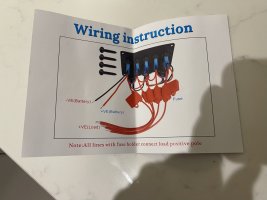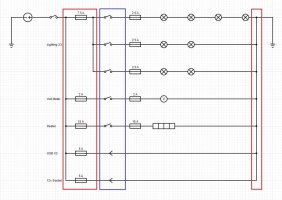Hi All,
Firstly for all of the help people have me when asking about leisure battery installs and what I need to do/purchase. I got some great advice from the likes of @Dellmassive and that’s what makes this forum the great place it is! I ended up buying a DC-DC Vitron Orion kit from Rayne Automotive and now trying to find time to wire the whole thing up and install the battery.
Next steps are working out how I go about completing the 12v install on the van.
The DC-DC kit came with fully finished cables and a 6 way fuse box and this is where my questions begin…….firstly people talk about an isolator after the battery. I assume this should be installed before the fuse box?
To keep things neat and simple I have also ordered on of the below control panels as in pics below. 5 switches, one 12v style lighter socket and two USB.



As can be seen this panel appears to have a single live feed from fuse board and then a single earth back down to earth. The switches then have fuses in the positive and I assume I then take back to earth after components.
So firstly should I use the single feed from fuse box to this unit or split them to individual feeds from fuse box?
In my lighting circuit should 12v led lights be wired in parallel or series?
I plan on running in wires so the van is prepped for heater and water when/if I decide to install. Will this dictate the answer to the single feed from fuse board?
Sorry for so many questions here just want to make sure I do a good job of this install
Firstly for all of the help people have me when asking about leisure battery installs and what I need to do/purchase. I got some great advice from the likes of @Dellmassive and that’s what makes this forum the great place it is! I ended up buying a DC-DC Vitron Orion kit from Rayne Automotive and now trying to find time to wire the whole thing up and install the battery.
Next steps are working out how I go about completing the 12v install on the van.
The DC-DC kit came with fully finished cables and a 6 way fuse box and this is where my questions begin…….firstly people talk about an isolator after the battery. I assume this should be installed before the fuse box?
To keep things neat and simple I have also ordered on of the below control panels as in pics below. 5 switches, one 12v style lighter socket and two USB.



As can be seen this panel appears to have a single live feed from fuse board and then a single earth back down to earth. The switches then have fuses in the positive and I assume I then take back to earth after components.
So firstly should I use the single feed from fuse box to this unit or split them to individual feeds from fuse box?
In my lighting circuit should 12v led lights be wired in parallel or series?
I plan on running in wires so the van is prepped for heater and water when/if I decide to install. Will this dictate the answer to the single feed from fuse board?
Sorry for so many questions here just want to make sure I do a good job of this install




